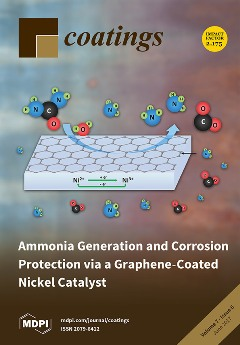UHTC composites were prepared by self-propagating high-temperature synthesis (SHS) from the Ti–B
4C reaction system with addition of Cr, Mo, and W. The starting sample composition was formulated as (3−
x)Ti + B
4C +
xMe with
x =
[...] Read more.
UHTC composites were prepared by self-propagating high-temperature synthesis (SHS) from the Ti–B
4C reaction system with addition of Cr, Mo, and W. The starting sample composition was formulated as (3−
x)Ti + B
4C +
xMe with
x = 0.1–1.0 and Me = Cr, Mo, or W. For all samples conducted in this study, self-sustaining combustion was well established and propagated with a distinct reaction front. With no addition of Cr, Mo, or W, solid state combustion of the 3Ti + B
4C sample featuring a combustion front temperature (
Tc) of 1766 °C and a combustion wave velocity (
Vf) of 16.5 mm/s was highly exothermic and produced an in situ composite of 2TiB
2 + TiC. When Cr, Mo, or W was adopted to replace a portion of Ti, the reaction exothermicity was lowered, and hence, a significant decrease in
Tc (from 1720 to 1390 °C) and
Vf (from 16.1 to 3.9 mm/s) was observed. With addition of Cr, Mo, and W, the final products were CrB-, MoB-, and WB-added TiB
2–TiC composites. The absence of CrB
2, MoB
2, and WB
2 was attributed partly to the loss of boron from thermal decomposition of B
4C and partly to lack of sufficient reaction time inherent to the SHS process.
Full article





